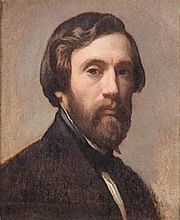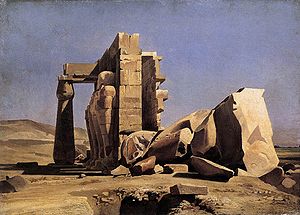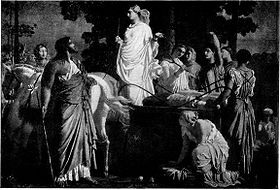
Marc-Charles-Gabriel Gleyre
Encyclopedia
Charles Gleyre (Chevilly, Vaud
canton, 2 May 1806 – 5 May 1874), was a Swiss
artist
. He took over the studio of Paul Delaroche in 1843 and taught a number of younger artists who became prominent, including Claude Monet
, Pierre Auguste Renoir, Alfred Sisley
and James Abbott McNeill Whistler.
 His father and mother died when he was eight or nine years of age; and he was brought up by an uncle in Lyon, France, who sent him to the industrial school of that city.
His father and mother died when he was eight or nine years of age; and he was brought up by an uncle in Lyon, France, who sent him to the industrial school of that city.
Going to Paris in his late teens, he spent four years in intense artistic study. The following four years Gleyre spent in meditative inactivity in Italy, where he became acquainted with Horace Vernet
and Louis Léopold Robert; and six years more were spent wandering in Greece
, Egypt
, Nubia
and Syria
. At Cairo he was attacked with ophthalmia, or inflammation of the eye, and in Lebanon
he was struck down by fever. He returned to Lyons in shattered health.
On his recovery he proceeded to Paris, and, establishing a modest studio in the rue de Université, began carefully to work out the ideas which had been slowly shaping themselves in his mind. Mention is made of two decorative panels Diana leaving the Bath, and a Young Nubian as almost the first fruits of his genius; but these did not attract public attention until much later, and the painting by which he practically opened his artistic career was the Apocalyptic Vision of St John, sent to the Salon
of 1840.
This was followed in 1843 by Evening, which at the time received a medal of the second class, and afterwards became widely popular under the title Lost Illusions. It depicts a poet seated on the bank of a river, with his head drooping and a wearied posture, letting his lyre
slip from a careless hand, and gazing sadly at a bright company of maidens whose song is slowly dying from his ear as their boat is borne slowly from his sight.
 In spite of the success of these first ventures, Gleyre retired from public competition, and spent the rest of his life in quiet devotion to his artistic ideals, neither seeking the easy applause of the crowd, nor turning his art into a means of aggrandizement and wealth. After 1845, when he exhibited the Separation of the Apostles, he contributed nothing to the Salon except the Dance of the Bacchantes in 1849. Yet he laboured steadily and was productive. He had an "infinite capacity of taking pains," and when asked by what method he attained to such marvelous perfection of workmanship, he would reply, "En y pensant toujours."
In spite of the success of these first ventures, Gleyre retired from public competition, and spent the rest of his life in quiet devotion to his artistic ideals, neither seeking the easy applause of the crowd, nor turning his art into a means of aggrandizement and wealth. After 1845, when he exhibited the Separation of the Apostles, he contributed nothing to the Salon except the Dance of the Bacchantes in 1849. Yet he laboured steadily and was productive. He had an "infinite capacity of taking pains," and when asked by what method he attained to such marvelous perfection of workmanship, he would reply, "En y pensant toujours."
Many years often intervened between the first conception of a piece and its embodiment, and years not infrequently between the first and the final stage of the embodiment itself. A landscape was apparently finished; even his fellow artists would consider it done; Gleyre alone was conscious that he had not "found his sky." His laboriousness became influential on a large number of his younger contemporaries; for when Delaroche gave up his studio of instruction he recommended his pupils to apply to Gleyre, who at once agreed to give them lessons twice a week, and characteristically refused to take any fee or reward.
By instinct and principle he was a confirmed celibate: "Fortune, talent, health, he had everything; but he was married," was his lamentation over a friend. Though he lived in almost complete retirement from public life, he took a keen interest in politics, and was a voracious reader of political journals. For a time, under Louis Philippe
, his studio had been the rendezvous of a sort of liberal club. To the last — amid all the disasters that befell his country — he was hopeful of the future, "la raison finira bien par avoir raison." It was while on a visit to the Retrospective Exhibition, opened on behalf of the exiles from Alsace and Lorraine
, that he died suddenly on 5 May 1874.
 He left unfinished the Earthly Paradise, a noble picture, which Taine has described as "a dream of innocence, of happiness and of beauty — Adam and Eve
He left unfinished the Earthly Paradise, a noble picture, which Taine has described as "a dream of innocence, of happiness and of beauty — Adam and Eve
standing in the sublime and joyous landscape of a paradise enclosed in mountains, a worthy counterpart to the Evening. Among the other productions of his genius are the Deluge, which represents two angels speeding above the desolate earth from which the destroying waters have just begun to retire, leaving visible behind them the ruin they have wrought; the Battle of the Lemanus, a piece of elaborate design, crowded but not encumbered with figures, and giving fine expression to the movements of the various bands of combatants and fugitives; the Prodigal Son, in which the artist has ventured to add to the parable the new element of mother's love, greeting the repentant youth with a welcome that shows that the mother's heart thinks less of the repentance than of the return; Ruth and Boaz; Ulysses and Nausicaa; Hercules at the Feet of Omphale; the Young Athenian, or, as it is popularly called, Sappho; Minerva and the Nymphs; Venus and Adonis; Daphnis and Chloë; and Love and the Parcae. Nor must it be omitted that he left a considerable number of drawings and water-colours, and that we are indebted to him for a number of portraits, among which is the sad face of Heinrich Heine
, engraved in the Revue des deux mondes for April 1852. In Clement's catalogue of his works there are 683 entries, including sketches and studies.
Vaud
Vaud is one of the 26 cantons of Switzerland and is located in Romandy, the French-speaking southwestern part of the country. The capital is Lausanne. The name of the Canton in Switzerland's other languages are Vaud in Italian , Waadt in German , and Vad in Romansh.-History:Along the lakes,...
canton, 2 May 1806 – 5 May 1874), was a Swiss
Switzerland
Switzerland name of one of the Swiss cantons. ; ; ; or ), in its full name the Swiss Confederation , is a federal republic consisting of 26 cantons, with Bern as the seat of the federal authorities. The country is situated in Western Europe,Or Central Europe depending on the definition....
artist
Artist
An artist is a person engaged in one or more of any of a broad spectrum of activities related to creating art, practicing the arts and/or demonstrating an art. The common usage in both everyday speech and academic discourse is a practitioner in the visual arts only...
. He took over the studio of Paul Delaroche in 1843 and taught a number of younger artists who became prominent, including Claude Monet
Claude Monet
Claude Monet was a founder of French impressionist painting, and the most consistent and prolific practitioner of the movement's philosophy of expressing one's perceptions before nature, especially as applied to plein-air landscape painting. . Retrieved 6 January 2007...
, Pierre Auguste Renoir, Alfred Sisley
Alfred Sisley
Alfred Sisley was an Impressionist landscape painter who was born and spent most of his life, in France, but retained British citizenship. He was the most consistent of the Impressionists in his dedication to painting landscape en plein air...
and James Abbott McNeill Whistler.

Going to Paris in his late teens, he spent four years in intense artistic study. The following four years Gleyre spent in meditative inactivity in Italy, where he became acquainted with Horace Vernet
Horace Vernet
Émile Jean-Horace Vernet was a French painter of battles, portraits, and Orientalist Arab subjects.Vernet was born to Carle Vernet, another famous painter, who was himself a son of Claude Joseph Vernet. He was born in the Paris Louvre, while his parents were staying there during the French...
and Louis Léopold Robert; and six years more were spent wandering in Greece
Greece
Greece , officially the Hellenic Republic , and historically Hellas or the Republic of Greece in English, is a country in southeastern Europe....
, Egypt
Egypt
Egypt , officially the Arab Republic of Egypt, Arabic: , is a country mainly in North Africa, with the Sinai Peninsula forming a land bridge in Southwest Asia. Egypt is thus a transcontinental country, and a major power in Africa, the Mediterranean Basin, the Middle East and the Muslim world...
, Nubia
Nubia
Nubia is a region along the Nile river, which is located in northern Sudan and southern Egypt.There were a number of small Nubian kingdoms throughout the Middle Ages, the last of which collapsed in 1504, when Nubia became divided between Egypt and the Sennar sultanate resulting in the Arabization...
and Syria
Syria
Syria , officially the Syrian Arab Republic , is a country in Western Asia, bordering Lebanon and the Mediterranean Sea to the West, Turkey to the north, Iraq to the east, Jordan to the south, and Israel to the southwest....
. At Cairo he was attacked with ophthalmia, or inflammation of the eye, and in Lebanon
Lebanon
Lebanon , officially the Republic of LebanonRepublic of Lebanon is the most common term used by Lebanese government agencies. The term Lebanese Republic, a literal translation of the official Arabic and French names that is not used in today's world. Arabic is the most common language spoken among...
he was struck down by fever. He returned to Lyons in shattered health.
On his recovery he proceeded to Paris, and, establishing a modest studio in the rue de Université, began carefully to work out the ideas which had been slowly shaping themselves in his mind. Mention is made of two decorative panels Diana leaving the Bath, and a Young Nubian as almost the first fruits of his genius; but these did not attract public attention until much later, and the painting by which he practically opened his artistic career was the Apocalyptic Vision of St John, sent to the Salon
Paris Salon
The Salon , or rarely Paris Salon , beginning in 1725 was the official art exhibition of the Académie des Beaux-Arts in Paris, France. Between 1748–1890 it was the greatest annual or biannual art event in the Western world...
of 1840.
This was followed in 1843 by Evening, which at the time received a medal of the second class, and afterwards became widely popular under the title Lost Illusions. It depicts a poet seated on the bank of a river, with his head drooping and a wearied posture, letting his lyre
Lyre
The lyre is a stringed musical instrument known for its use in Greek classical antiquity and later. The word comes from the Greek "λύρα" and the earliest reference to the word is the Mycenaean Greek ru-ra-ta-e, meaning "lyrists", written in Linear B syllabic script...
slip from a careless hand, and gazing sadly at a bright company of maidens whose song is slowly dying from his ear as their boat is borne slowly from his sight.

Many years often intervened between the first conception of a piece and its embodiment, and years not infrequently between the first and the final stage of the embodiment itself. A landscape was apparently finished; even his fellow artists would consider it done; Gleyre alone was conscious that he had not "found his sky." His laboriousness became influential on a large number of his younger contemporaries; for when Delaroche gave up his studio of instruction he recommended his pupils to apply to Gleyre, who at once agreed to give them lessons twice a week, and characteristically refused to take any fee or reward.
By instinct and principle he was a confirmed celibate: "Fortune, talent, health, he had everything; but he was married," was his lamentation over a friend. Though he lived in almost complete retirement from public life, he took a keen interest in politics, and was a voracious reader of political journals. For a time, under Louis Philippe
Louis-Philippe of France
Louis Philippe I was King of the French from 1830 to 1848 in what was known as the July Monarchy. His father was a duke who supported the French Revolution but was nevertheless guillotined. Louis Philippe fled France as a young man and spent 21 years in exile, including considerable time in the...
, his studio had been the rendezvous of a sort of liberal club. To the last — amid all the disasters that befell his country — he was hopeful of the future, "la raison finira bien par avoir raison." It was while on a visit to the Retrospective Exhibition, opened on behalf of the exiles from Alsace and Lorraine
Alsace-Lorraine
The Imperial Territory of Alsace-Lorraine was a territory created by the German Empire in 1871 after it annexed most of Alsace and the Moselle region of Lorraine following its victory in the Franco-Prussian War. The Alsatian part lay in the Rhine Valley on the west bank of the Rhine River and east...
, that he died suddenly on 5 May 1874.

Adam and Eve
Adam and Eve were, according to the Genesis creation narratives, the first human couple to inhabit Earth, created by YHWH, the God of the ancient Hebrews...
standing in the sublime and joyous landscape of a paradise enclosed in mountains, a worthy counterpart to the Evening. Among the other productions of his genius are the Deluge, which represents two angels speeding above the desolate earth from which the destroying waters have just begun to retire, leaving visible behind them the ruin they have wrought; the Battle of the Lemanus, a piece of elaborate design, crowded but not encumbered with figures, and giving fine expression to the movements of the various bands of combatants and fugitives; the Prodigal Son, in which the artist has ventured to add to the parable the new element of mother's love, greeting the repentant youth with a welcome that shows that the mother's heart thinks less of the repentance than of the return; Ruth and Boaz; Ulysses and Nausicaa; Hercules at the Feet of Omphale; the Young Athenian, or, as it is popularly called, Sappho; Minerva and the Nymphs; Venus and Adonis; Daphnis and Chloë; and Love and the Parcae. Nor must it be omitted that he left a considerable number of drawings and water-colours, and that we are indebted to him for a number of portraits, among which is the sad face of Heinrich Heine
Heinrich Heine
Christian Johann Heinrich Heine was one of the most significant German poets of the 19th century. He was also a journalist, essayist, and literary critic. He is best known outside Germany for his early lyric poetry, which was set to music in the form of Lieder by composers such as Robert Schumann...
, engraved in the Revue des deux mondes for April 1852. In Clement's catalogue of his works there are 683 entries, including sketches and studies.

